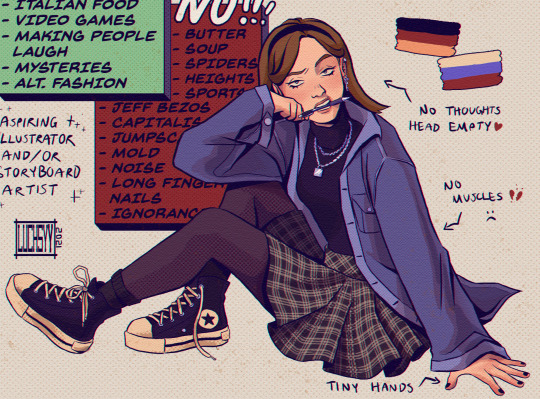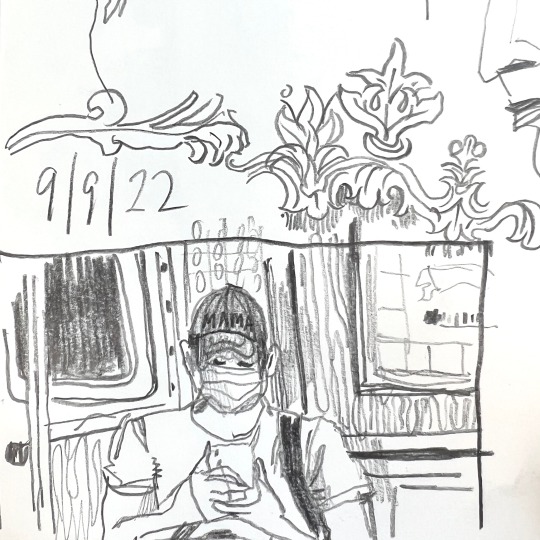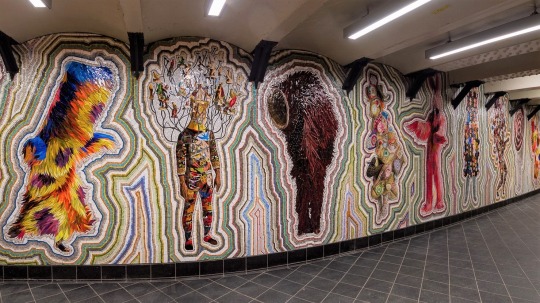#mta 2021
Text


the difference between what i think is my first ever meet the artist (september 11th 2021) and my most recent one (july 23 2023) is so wild like. what i thought was dysphoria wasnt gender dysphoria at all idek what it mightve been. also i dont use any of those labels or half of the names anymore.
there are a few differences that are easily pointed out; the artstyle & hair are two of my favourites. like my sideshave has grown a lot in two years and also my hair is dark red right now
#layout of my meet the artists has changed too. also i have a somewhat consistent sona. i could go on \and on about the differences and-#-maybe i will do so someday#slushii draws sometimes#also just realised that- while my pronouns changed a lot between late 2021 and early 2023- in these mtas specifically they barely changed
5 notes
·
View notes
Photo

new meet the artist for 2023 :]
older me from older MTAs (2021-2020-2019-2016-2015)....... i think it’s really interesting to observe how my art style, clothing style and self-perception has changed over the years



#my art#meet the artist#meet the artist 2023#mta#digital art#illustration#about me#self portrait#improvement#'WHY DO YOU HATE SOUP/BUTTER' comments incoming
253 notes
·
View notes
Text
Dr. Radics Kornélia
Radics Kornélia Nagykanizsán született 1973. június 29-én. A középiskola elvégzése után az ELTE Meteorológus Szakán folytatta tanulmányait. 1997-ben meteorológus, 1999-ben csillagász oklevelet szerzett. Már az első diploma kézhezvétele után jelentkezett az ELTE Földtudományi Doktori Iskolájának Földrajz-Meteorológia doktori programjára. PhD fokozatát 2004-ben "A szélenergia hasznosításának lehetőségei Magyarországon: hazánk szélklímája, a rendelkezésre álló szélenergia becslése és modellezése" témájú doktori dolgozatával szerezte meg.
2001-től a Magyar Honvédség Meteorológiai Szolgálat Információtechnikai és Koordinációs Osztályán 2007-től az MH Geoinformációs Szolgálat, Időjárás Előrejelző és Szakkiképzési Osztályán töltötte be a meteorológus főtiszti, majd osztályvezető-helyettesi pozíciót.
1997-ben kezdte oktatói pályafutását a tanulmányai mellett. Az ELTE Meteorológiai Tanszékén Klimatológia, Válogatott fejezetek a matematikából, Bevezezés a meteorológiába, Katonai meteorológia, Repülésmeteorológia tárgyakat oktatta, s részt vett különböző szaktanfolyamok oktatási tevékenységében az Alkalmazott meteorológia, Általános meteorológia, Klimatológia tárgyak ismereteinek átadásával.
Egyetemi évei alatt számos hazai és külföldi ösztöndíjat nyert. 1995-ben a Soros Alapítvány Ösztöndíjával az International Conference of Physics Students rendezvényén vett részt Koppenhágában; 1995-ben IAESTE ösztöndíjjal 3 hónapot Brazíliában a sao paulo-i egyetemen; 1998-ban egy hónapot az European Science Foundation ösztöndíjával Svédorszában, Bornö-ben; az European Research Course on Atmospheres keretében pedig 1 hónapot a franciaországi Grenoble-ban töltött. 1999-ben kétszer 3 hónapot töltött a University of Uppsalan, Svédországban ERASMUS ösztöndíjjal, illetve egy posztgraduális kurzus keretében, majd 1 hónapot Spanyolországban, Palma de Mallorcan European Science Foundation ösztöndíjjal. 2002-ben NATO ösztöndíjjal Párizsban, majd Nagy-Britanniában, Manchesterben vett részt nemzetközi konferenciákon.
Kiváló tanulmányi eredményeit, kutatómunkáját, a szakmai feladatok színvonalas ellátását díjak, elismerések, ösztöndíjak tükrözik. A Magyar Meteorológiai Társaság 1996-ben Hille Alfréd Díjjal, 2005-ben Róna Zsigmond Ifjúsági Díjjal tüntette ki. A Magyar Tudományos Akadémia Pro Scientia Aranyérmét 1997-ben kapta meg, majd elnyerte az MTA Bolyai János Kutatási Ösztöndíját a 2005 és 2011 közötti időszakra.
A Honvédelmi Minisztérium Honvéd Vezérkar főnökétől 2005-ben kapott Emlékplakettet, 2007-ben a Szolgálati Érdemjel bronz fokozatát, 2011-ben a Tiszti Szolgálati Jel III. fokozatát, 2012-ben a Szolgálati Érdemjel ezüst fokozatát kapta.
Szakmai munkája elismeréseként 2013-ban a vidékfejlesztési miniszter Pro Meteorologia Emlékplakettet adományozott számára.
1995-től 12 kutatási projekt munkájában vett részt (OTKA, COST, EU). A legfontosabb kutatási témák ezeken belül: szélklíma, klímaváltozás, szélenergia, megújuló energiaforrások, levegőkörnyezeti elemzések.
2013 novemberében nevezték ki az Országos Meteorológiai Szolgálat elnökének.
A Meteorológiai Világszervezet VI. régiója (Európa, Közel-Kelet és Kaukázus térsége, WMO RA VI) a 2021–2025-ös időszakra elnökének választotta.
2022. augusztus 22-én Palkovics miniszter kirúgta mert az előrejelzések ellenére nem esett az eső Budapesten augusztus 20-án este.
269 notes
·
View notes
Text
The MTA’s latest congestion pricing scheme: Charge runners for crossing the Verrazzano-Narrows Bridge.
The transit agency is waging war against the organizers of the New York City Marathon, demanding $750,000 to make up for toll revenue lost during the iconic race.
And if New York Road Runners doesn’t pay up, the agency is threatening to restrict use of the bridge, potentially reducing the number of runners who can compete in the wildly popular event each November, the New York Times reported Wednesday, citing internal memos.
During hardball negotiations, the MTA initially said runners — who start the marathon on Staten Island — would only be allowed to use the darker lower deck of the bridge for the 26.2-mile race if organizers don’t pay up.
Officials backtracked slightly, though, in recent weeks by saying marathon organizers could have their pick of the upper or lower level for the race — but not both, according to the memos.
The marathon, which is expected to draw 50,000 entrants for this year’s race, has used both decks of the Verrazzano Bridge for the past 36 years.
New York Road Runners isn’t caving to the MTA’s demands.
They have argued they’ll have to likely restrict the number of entries going forward if runners are banned from using both levels. Otherwise, the race’s duration will have to be extended — meaning the bridge and local streets will be shuttered for longer to allow all runners to complete the race, according to the memos.
“New Yorkers love Marathon Sunday, but taxpayers cannot be expected to subsidize a wealthy nongovernment organization like the New York Road Runners to the tune of $750,000,” the president of MTA Bridges and Tunnels, Catherine Sheridan, said in a statement.
“The MTA is prepared to continue working toward a final agreement with the NYRR, provided it leads, over time, to full reimbursement for the lost revenue.”
In 2021, New York Road Runners started paying some personal costs tied to shutting down the bridge for the marathon. For last year’s race, the group said it forked over $150,000.
Separately, the MTA has also demanded Bike New York — an organization that uses the bridge’s bottom level during its annual Five Boro Bike Tour each May — to cough up, too.
It wasn’t immediately clear how much Bike New York has been ordered to pay, but the transit agency threatened to ban the group from using the bridge if it doesn’t agree, the Times reported.
News of the negotiations emerged a week after the MTA’s board approved the controversial congestion pricing plan to slap drivers with a $15 toll to enter Midtown Manhattan below 60th Street.
The MTA has long argued the increased tolls will generate billions for much-needed transit and railroad upgrades for the cash-strapped system.
The tolls on the Verrazzano Bridge, too, subsidize the Big Apple’s subway and bus system.
9 notes
·
View notes
Text





Sharing a new addition to the Poetry in Motion collection!
Selected in collaboration with @poetrysociety, “Morning Bell” by Iman Mersal is set with imagery from Marcel Dzama’s mosaic “No Less Than Everything Comes Together” (2021) at Bedford Av (L) station. Dzama’s artwork, containing curious characters set in a palette of nighttime blues, was inspired by Walt Whitman’s iconic poem “Crossing Brooklyn Ferry.” A beautiful coincidence unbeknownst to the artist at the time, Whitman’s poem was part of the Poetry in Motion program’s pilot release in 1992.
Find “Morning Bell” throughout the transit system, presented in print and on digital screens throughout the subway, and on digital screens in commuter rail cars and stations.
"Morning Bell" by Iman Mersal, translated by Robyn Creswell, from The Threshold. Copyright © 2022 by Iman Mersal and Robyn Creswell. Reprinted with the permission of Farrar, Straus and Giroux. No Less Than Everything Comes Together (2021) © Marcel Dzama, NYC Transit Bedford Av Station.
Commissioned by MTA Arts & Design. Photo by MTA/Trent Reeves.
27 notes
·
View notes
Photo


Gossip Girl (2007) S01 E01: Pilot
Gossip Girl (2021) S01 E01: Just Another Girl on the MTA
#gossip girl#gossip girl 2021#blair waldorf#audrey hope#filmedit#movieedit#cinemapix#chewieblog#userbbelcher#dailyflicks#useroptional#moviegifs#edits#userrubys#userfrodosam#usermaya#userrobin#ryancoogler#tusertha#usermandie
397 notes
·
View notes
Text
Content Warning: This story includes references to suicide. If you need help, call the Suicide and Crisis Lifeline for your region.
In 2021, an unidentified Black woman died by suicide after jumping off the Brooklyn Bridge. She was wearing hot-pink nail polish, and had a pink left eyebrow piercing and several tattoos—all distinguishing features that should have made it easier to identify her. Two years later, her identity is still unknown.
The tragedy of unidentified cadavers is something that Rionna Lee has been thinking about for years. Her mother used to transport human remains for New York’s Office of the Chief Medical Examiner, and would bring home morbid stories. One, Lee remembers, was of a man who had been hit by an MTA train. “One of the things that stuck out to me was the condition of his remains, which were scattered across the train tracks,” says Lee, 24, who now lives in Kingston, Pennsylvania. It distressed her to think of the families who would have to identify their loved ones—even more so, later, when she learned that some human remains would never be identified.
There are an average of 4,400 unidentified new cadavers per year in the US, and a total of 600,000 missing people across the country. Some of these cases are collected on databases, such as the National Missing and Unidentified Persons System (NamUs), which helps medical examiners, coroners, law enforcement officers, and members of the public solve missing, unidentified, and unclaimed cases across the country. The true scale of the problem is unknown, as the data available for the average number of unidentified cadavers comes from a 2004 census. Just 10 states have laws requiring that cases be entered into NamUs, meaning that many reports are voluntary.
As she looked into cases—including the woman with the pink nail polish—Lee noticed a pattern in which cases were solved and which weren’t. The decisive factor was often money. Funding from private donors, sponsorship, and public support meant that law enforcement agencies were able to access cutting-edge technology, such as Othram, a forensic genetics company, which has been pivotal in cracking several high-profile cases. Those that weren’t solved didn’t have resources behind them. Often, they were from marginalized groups. Lee, who identifies as Black and LGBTQ+, felt the need to raise awareness among overlooked members of society, those whose deaths often go unnoticed: transient individuals, racial minorities, substance users, and members of the LGBTQ+ community.
Lee set up a TikTok to try to raise awareness. After a few false starts, she went viral, attracting a following of 128,000. She set up a Facebook group—Thee Unidentified & Unsolved—which now has 39,000 members, many of whom work together to solve unidentified and unsolved cases. Thee Unidentified & Unsolved is one of several volunteer social media communities that are filling a gap left by the US state, a gap that is getting worse due to the overlapping crises of poverty, fentanyl, and shortfalls in public funding. Now, with AI image recognition more readily available, volunteers have new tools to help them identify the deceased. This brings with it new issues around privacy and consent, but those in the communities say their work brings closure to families. “I believe everyone starts off with a name,” says Lee. “I believe everyone should be able to leave this earth peacefully with their name.”
Lee started her TikTok campaign in October 2021. There were already several popular accounts that focused on locating missing people, but few, if any, were working to identify the deceased. She created her own page, but TikTok doesn’t allow graphic content such as morgue photos, and she struggled for traction.
She focused on cases where the decedent had been found with items that might help their friends and relatives identify them. “One of the videos I posted that gained exposure was a man with an undetermined race. He was found with a Salvatore Ferragamo gold buckle belt,” says Lee. Her audience was curious how a person with such an expensive piece of clothing could go unidentified. Her engagement grew, and finally, on November 9, 2022, one of her TikTok videos—the case of a 2022 Union County Jane Doe, a Black woman who died after being struck by multiple vehicles on US Route 22 in Hillside, New Jersey—went viral, racking up 652,000 views. A couple of days later, another video hit a million views. She created the Facebook group later that month, because the platform allows graphic content, like morgue pictures, which TikTok doesn’t.
There are around a dozen posts each day in the group, often unsolved cases from NamUs with pictures. Members scour the internet, looking for other images, comparing images with missing person sketches or social media profiles.
Some of the identification groups work globally; others are region- or country-specific or dedicated to unique circumstances, such as missing and murdered Indigenous women and girls. Online detective groups often tread a delicate line between altruistic investigation and mob obsession.
Thee Unidentified has had to tread that line carefully. Earlier this year, the group helped identify Adonis Beck, a TikTok star also known as Pope the Barber. Beck was found dead on August 10. The news spread quickly, causing an influx of new members to the Facebook group. Kenyetta Burks, one of the group’s admins who had first posted Beck’s image in the group, removed the morgue photos as they were posted, but was inundated with requests from people trying to see them, many from fake accounts pretending to be relatives. Sometimes, the admins will notice comments from members who seem more intrigued by the circumstances of death than those who are empathetic to the topic of unidentified cases. In situations that appear voyeuristic, the person is suspended, and if the behavior is repeated, they are banned, Lee says.
These social media groups have helped some families find closure. In 2022, a teenage boy stumbled upon Lee’s TikTok page and identified his mother, a 2017 Jane Doe case, via her tattoos. She was hit by a vehicle while crossing a street in Pasadena, California, and succumbed to her injuries in hospital. In May 2023, Burks posted a sketch, images, and information from NamUs in the Facebook group, which led to the identification of Dytavious Sanders, an MMA fighter from South Carolina, whose body was discovered earlier that month on May 9. Sander’s aunt identified him in the group and his mother asked for assistance in claiming his body.
One member of Thee Unidentified has recently began using a new tool, PimEyes, a controversial facial recognition search engine, as a means to identify the deceased via morgue photos. A quick upload produces search results in a matter of seconds. Photos from across the internet are organized in a single view, mugshots frequently among them. While this technology can accelerate the process of identifying the dead, it brings with it serious privacy concerns. In many cases, informed consent is obtained for neither the image uploaded nor the results that the technology returns, which can include the biometric data of private individuals. Thus far, a few members of the group have utilized this tool.
“While some individuals might be well meaning, online sleuths are using dangerous surveillance tools,” says Madeleine Stone, senior advocacy officer at Big Brother Watch, a privacy campaign group. “By selling this technology, facial recognition companies risk violating the dignity of deceased individuals, but moreover are violating the privacy rights of the billions of people whose photos they have taken, processed, and exploited without consent.”
PimEyes has been criticized by privacy advocates for scraping the internet for images and giving users access to highly personal information about private individuals. PimEyes CEO Giorgi Gobronidze says that these threats are exaggerated, and that PimEyes doesn’t hold images but just directs users to the URLs where images are hosted. “The tool is designed to help people to find the sources that publish photos, and if they shouldn't be there, apply to the website and initiate takedown.” Gobronidze says that PimEyes has many use cases, such as searching for missing people, including women and children in conflict areas, and actively cooperates with human rights organizations.
Lee says that the Thee Unidentified & Unsolved Facebook group “is not focused on the use of PimEyes … But I respect those who do use the tool and actually have successful outcomes.”
In other social media groups, PimEyes is slowly being introduced as an investigative tool for cases related to missing persons, cold cases, and human trafficking.
Experts also worry that this technology is not necessarily accurate, meaning that amateur sleuths could make mistakes with heartbreaking consequences. “This a noble goal, but a terrible approach,” says Albert Fox Cahn, executive director of the Surveillance Technology Oversight Project, an organization that litigates and advocates for privacy and fighting excessive local- and state-level surveillance. “This technology is biased and error prone, and I worry that a lot of worried families will be wrongly told their missing loved one is dead.”
For all of the challenges presented by volunteer online communities, the reality is that they exist in a vacuum left by the authorities.
In 2021, 106,699 Americans died of an overdose. In Seattle, the fentanyl crisis is so bad that the number of overdose deaths has doubled in the past three years, causing the morgues to overflow. The “fourth wave” of the crisis recently descended upon the US, an ongoing mass-overdose event that has consumed law enforcement agencies, stretching the resources necessary for identifying the dead. For medical examiners, the “tsunami” of bodies has resulted in staff burnout, exhausted resources, and the jeopardizing of many offices’ accreditation due to the necessity to conduct more autopsies than industry guidelines permit.
“Unfortunately, the opioid crisis has meant more individuals are coming into the Medical Examiner’s Office for examination,” says Constance DiAngelo, Philadelphia’s chief medical examiner. “Many of these folks are not initially identified.”
The authorities just don’t have the resources to investigate every case thoroughly. “Our challenges are related to funding,” DiAngelo says. “Exhumations, reinterment, DNA extraction and processing, and genealogy comparisons are expensive. A case could cost between $2,500 and $10,000, and that doesn’t include the need for staff who can be dedicated to this type of work.”
In King County, where Seattle is located, there are currently 57 unidentified people that the Medical Examiner’s Office is working to identify. This dire situation is a reality across major American metropolitan areas. In situations where people are found without identification, it can take weeks, if not months, to locate next of kin.
That waiting, and not knowing, can be agony for people whose loved ones have disappeared—like the family of Kallie Catron. Catron’s mother, Crystal Newman, last spoke with her on October 14, 2022. Catron said she missed her two children and wanted to come home. “When Halloween, Thanksgiving, Christmas, and New Year’s passed, my sister knew something was wrong and called to report a missing person,” says Sarah Forister, Catron’s aunt. “I guess you can say a mother knows when something is wrong with her baby.”
On January 22, 2023, Newman was sent a link to a post on Thee Unidentified’s TikTok page. Morgue photos, and images of her tattoos, confirmed it was Catron. “At first, we were so mad that’s how we found out,” says Forister. “But Kallie’s mom, me, and her cousins watched the video showing her morgue photo and all her identifying tattoos multiple times a day.”
Eventually, Lee asked the family whether she could take down the video, as Catron had been identified. “I said yes, but please send me the video so I can watch it whenever I want to,” says Forister. Lee obliged. The community shared the family’s GoFundMe campaign to raise funds for Catron’s funeral and to support her children. “We realized that if it wasn’t for Thee Unidentified community and Rionna, we could still be looking for Kallie,” Forister says.
14 notes
·
View notes
Text
magyarul: csak térdig ér a szar európában, de orbánnak sikerült nyakig meghempergetni bennünket.
Bod Péter Ákos: Itt valami filmszakadás van
Magyari Péter
GAZDASÁG
szeptember 29., csütörtök 15:41
Bod Péter Ákost, egykori ipari minisztert és jegybankelnököt, egyetemi tanárt és az MTA doktorát kérdeztük, hogy mekkora bajban lehet a költségvetés.
A nyilvános adatok alapján nem érti, hogy miért kellett elrendelni a kiadások befagyasztását a költségvetési intézményeknél.
Azt viszont látja, hogy miért van rosszabb állapotban nálunk a költségvetés, mint az európai országok többségében.
Az energiaárak befagyasztása elodázta a gazdaság alkalmazkodását az áremelkedésekhez, és a fizetési mérleget is felborította.
A kormány vitája az EU-val hozzájárult a forint rendkívüli gyengüléséhez.
Az ellentmondásos, zavaros, kapkodásra utaló kormányzati kommunikáció pedig tovább ront az ország helyzetén.
Egy nem nyilvános kormányhatározat alapján kifizetési stopot rendeltek el a napokban a kormányzati intézményeknél. Ez mennyire szokatlan intézkedés?
Mindenképpen szokatlan, a 70-es években történt hasonló, bár akkoriban alapvetően a devizában történő kifizetéseket érintették az intézkedések. A közelmúltból nem tudok felidézni ilyet. Ez nagyon rövid időre szóló, átmeneti megoldás lehet csak. Nem ismerjük a rendeletet, mert nem nyilvános, de ha jól értem, akkor a béreket kifizetik, de az egyéb számlákat félreteszik. Ilyen előfordul cégek életében, hogy fizetési haladékot kérnek, de egy állam esetében ez kétségtelenül szokatlan.
Ha valaki nem fizeti ki a számláit, akkor ez azt jelenti, hogy csődbe ment?
Nem, ez szerződésszegésnek tekinthető inkább, aminek nyomán lehet akár perelni is. Ha jól értem, akkor a rendőrség például kifizeti a rendőrök bérét, de a gumibotgyártó számláit félreteszi, hogy majd később rendezi csak, mondjuk egy hónap múlva.
Akkor fordulhat ez elő, ha likviditási probléma van. Vagyis azt gondolja valaki, hogy most ugyan nincs pénze, de később majd lesz.
De nem értem, ez hogyan fordulhatott elő, mert a magyar államnak van egy folyószámlája, amit hizlalnak az adóbevételek, és ha további likviditásra van szüksége, akkor állampapírokat bocsáthat ki. Tehát elvben meg kellene lenniük a kifizetések fedezetének. Bár mennek fel a kamatok, de azért állampapírok kibocsátásával fel lehetne tölteni a folyószámlát. Ezért a helyzet számomra érthetetlen.
Bod Péter Ákos Fotó: 444
Ilyenkor felmerül az a kérdés is, hogy jót tesz-e egy kormány pénzügyi megítélésének, ha nem fizeti ki a tartozásait. A belföldi szereplők esetében persze ez nem annyira éles helyzet, mert akiknek tartozik most az állam, azok feltételezésem szerint várni fognak egy hónapot, hogy hozzájussanak a pénzükhöz, és nem viszik bíróság elé a magyar államot. Ez költséges és politikailag is érzékeny ügy lenne.
Megjelent csütörtökön egy elemzése, ami a devizatartalékok csökkenésére és a magyar állam finanszírozásának drágulására figyelmeztet. Ezek mennyire aggasztó folyamatok?
A magyar külső egyensúly az utóbbi években nem volt téma, mert a külkereskedelmi mérleg szufficites volt, és az uniós pénzek érkezése miatt a tőkemérleg is pozitív maradt. Ebben történt egy erőteljes változás 2021 nyara óta. A nemzeti bank adatain az látszik, hogy a pénzügyi mérleg 2019-ben még teljes egyensúlyban volt, 2020-ban deficitbe váltott át, 2021-ben megnőtt a deficit, és ez ugrott meg még inkább 2022 első félévében, óriási romlást hozva.
Ez nem meglepő, mert a magyar kivitel nagyjából adott, nem változott, míg a behozatalban nagyon jelentős tételt tesznek ki az energiahordozók. Az energia ára pedig óriásit emelkedett. Ezzel a cserearányok romlottak. Ha a külkereskedelmi mérleg romlik, és ezt más tételek nem tudják kompenzálni, azaz nem érkeznek az EU-s transzferek, akkor a folyó fizetési mérleg nagyot esik.
A devizatartalék elég nagy, 35 milliárd euró volt az év felénél, ez normális körülmények között elfogadható. Csakhogy közben nagyon romlik a fizetési mérleg, és ha ez így folytatódik, akkor a tartalék apadása már aggasztó lesz.
A tartalékokat kötvények kibocsátásával lehetne feltölteni, vagyis hitelt kellene felvenni. Csakhogy ezekben a napokban a hitelek az egész világon drágulnak, különösen a kockázatos országok számára. És a magyar adósbesorolás a visegrádi országok közül a leggyengébb, sőt még Bulgáriáé és Horvátországé is jobb a mienknél. A környéken csak a románokénál jobb a miénk, ők viszont az euróövezethez készülnek csatlakozni, és ez enyhíti a problémáikat. Tehát drágábban kap a magyar állam hitelt, mint a többi ország a környéken.
Ez a probléma és a kiadási stopot kikényszerítő likviditási probléma összefüggenek egymással?
Lehet, de ezt nem tudhatjuk. Nehéz megérteni, hogy a forintlikviditással hogyan lehet gond, hiszen a borzasztó mértékben ránk szabadult infláció a költségvetés szempontjából tulajdonképpen kellemes állapot. Hiszen ha valaminek az ára megdrágul, akkor az áfabevételekből is sokkal több érkezik be. Úgyhogy itt valami filmszakadás van, csak nem látjuk külső elemzőként, hogy micsoda.
Az adatokat a pénzügyminiszter látja csak, és valószínűleg a miniszterelnököt ő olyan számokkal lepte meg, amelyek alapján ehhez a szokatlan és átmeneti próbálkozásnak tekinthető megoldáshoz fordult, azaz arrébb tolta néhány héttel az esedékes kifizetéseket.
Innentől csak találgatni lehet, hogy milyen adatok vezettek ide. Lehetséges például, hogy az állami beruházások leállításával nem lehetett annyi pénzt megtakarítani, mint ahogy ezt tervezték.
A közgazdász vándorgyűlésen (szeptember 22-23) érződött, hogy a viszonyok gyorsan romlanak, a pénzügyminiszter kimondta a recesszió szót is. Arra azonban nem utalt, hogy a költségvetés belső szerkezetében akut gond lenne.
A magyar költségvetés és általában a magyar gazdaság nehéz helyzete illeszkedik a globális trendhez is, hiszen egész Európában komoly problémák vannak. Mekkora a magyar kormányzat felelőssége a magyarországi gondok kialakulásában?
Alapvetően ez “made in Hungary”. A külső viszonyok olyanok, amilyenek. Van, hogy egy gázvezeték kilyukad, megugrik az ár, és ez megzavarja a piacokat, ezzel nincs mit kezdeni. De közben világosan látszik, hogy Nyugat-Európában a vártnál lendületesebben halad az energetikai átállás. Ez nagy költségekkel jár, de az infláció a legtöbb országban már elérte a csúcsát, vagy a következő hetekben éri el, az energia- és élelmiszerárak emelkedésének egyszeri sokkján lassan túl vannak. A fogyasztói árak 9 százalékpontos emelkedése az eurózónában várhatóan már nem megy feljebb, és lassan megkezdődik a normalizálódás.
Nálunk azonban sajátos a helyzet. Az energiaárak emelkedése 2021-ben indult, nem az orosz agresszió másnapján, az csak egy újabb lökést adott neki. Európa nagy részén az alkalmazkodás már 2021-ben megkezdődött a dráguláshoz, de itthon a rezsicsökkentésnek nevezett hatósági árrögzítés miatt ez az alkalmazkodás nem történt meg. Ráadásul az árrögzítést abszurd módon a motorüzemanyagokra is kiterjesztették. Ezek súlyos gazdaságpolitikai hibák voltak, amelyeknek következményei a fizetési mérlegben jelentek meg. Ugyanis a szubvenciók miatt az energiaimport nem csökkent, itt nem kezdődött spórolás, mint máshol Európában. Ettől szenvedett el nagyobb a veszteséget a magyar gazdaság, mint az uniós átlag.
Ehhez a strukturális okhoz jön még hozzá egy speciális ok is: a forint meglepő gyengülése. A forint sokat mozgott az utóbbi hónapokban, általában zuhant, utána egy kis jegybanki beavatkozás nyomán kicsit visszajött, aztán még inkább zuhant, és sose tud visszajönni oda, ahol volt. Ez a trendszerű gyengülés is beépült az árakba, ezért az élelmiszerárak és a lakhatási költségek Magyarországon lényegesen nagyobb mértékben emelkedtek, mint Európa nagy részén. Ez azért van, mert a forint gyengült a leginkább a régióban.
Ez a különös mértékű forintgyengülés a magyar gazdaság és politika kockázatossá válása miatt történt, különös tekintettel az EU-s kapcsolatrendszer elbizonytalanodására. Hiszen ha az EU-s újjáépítési csomag nem jut el hozzánk, és a kedvezményes hitelt sem képes felvenni a magyar kormány, akkor a pénzügyi piacok szerint Magyarországon gond lehet. Ez a vélekedés, hogy gond lehet, már rögtön gondot is okoz, hiszen a forint iránti kereslet csökken, azaz a cégek és az emberek igyekeznek nem ülni a forintjukon, hanem átrakják a megtakarításaikat másba.
Ha mindezeket összerakom, akkor nagymértékű egyensúlytalanság áll elő. Ám ebből még mindig nem következik a belső költségvetés likviditási problémája. A legőszintébb válasz ezért az, hogy nem tudjuk, hogy mi történik ott. Ez már három-négy éve sem volt teljesen transzparens terület, de most aztán pláne nem ez.
Mi lenne most a felelős kormányzati beavatkozás?
Bizonyos horgonyok hiányoznak. Ha egyértelmű lenne, hogy a magyar költségvetést igyekeznek egyensúlyi irányba mozdítani, az megnyugtatna mindenkit.
A pénzügyminiszter bejelentette, hogy az idei deficit a tervezettnél nagyobb lesz, de közben arról is voltak bejelentések, hogy újabb adócsökkentés jön. Ezek ellentétes értelmű szövegek. Miközben a miniszterelnök egyik embere kimondja, hogy az árrögzítés nem jó, utána ugyanaz a kormány, ugyanazon a héten meghosszabbítja az árrögzítést.
Amikor elmondja a pénzügyminiszter, hogy a helyzet nem olyan jó, recesszió is elképzelhető, azaz a kormány bevételi alapja sem nő, akkor nem lehet nagyvonalú kiadásnövelési terveket szóba hozni. Erre 6000 milliárdos energetikai beruházásról, és nagyvonalú szja-elengedésről tesznek bejelentést. Ezek az ellentmondások nem stabilizálják a várakozásokat, nincsenek gazdaságpolitikai horgonyok. Ezek kapkodásra, improvizációra utalnak, előfordul, hogy negyedórán belül három ellentmondás fedezhető fel a kormány kommunikációjában.
Szintén politikai probléma, hogy a kormány olyan törvényeket terjeszt be, amelyeknek már a címében és indoklásában is benne van, hogy csak azért hozzák meg őket, hogy eleget tegyenek az uniós pénzosztási feltételeknek. Ez azért abszurd, mert a törvényhozásnak jó törvényeket kellene alkotnia, hogy a magyar állam jobb hatásfokkal működjön. A látható kényszeredettség viszont aláássa a törvények célját, mégpedig azt, hogy meggyőzzék a belső és külső szereplőket, hogy a magyar kormányzat az állami képességeket és a jogkövető magatartását javítani akarja.
Egyszerre ígérnek illeszkedést az EU-s elvárásokhoz, és közben elindul egy médiaakció „nemzeti konzultáció” címen, ami az európai partnerek többsége által határozottan képviselt szankciók megkérdőjelezéséről szól. Ha a kettőt összerakom, akkor nem látszik, hogy mit akar igazából a kormányzat.
Ezek az egymást kizáró mondatok a bizonytalanság növelését idézik elő egy olyan időszakban, amikor a háború és a világpiaci folyamatok helyreállításának zökkenői miatt egyébként is nagy a bizonytalanság. Tele van a világ egy halom kockázattal, és erre jön még rá a magyar kockázat. Ezért gyengül jobban a forint, mint a cseh korona vagy akár a lengyel zlotyi. A cseh és a lengyel kormányok nem gerjesztik a kockázatokat, még ha utóbbi bizonyos ügyekben szemben is áll az európai fősodorral. A magyar kormány esetében viszont nem tudok olyan állítást tenni, amit a következő tíz percben ugyanaz a hatalmi kör meg ne kérdőjelezne.
43 notes
·
View notes
Text

I posted 1,757 times in 2022
That's 1,161 more posts than 2021!
856 posts created (49%)
901 posts reblogged (51%)
Blogs I reblogged the most:
@neon-moon-beam
@gummycore
@chingaderita
@autisticwolfesbrainisautistic
@shotsofnovacaine
I tagged 1,757 of my posts in 2022
#reblogs - 902 posts
#pokemon - 699 posts
#replies - 628 posts
#submas - 492 posts
#i like trains - 276 posts
#drawing - 88 posts
#art - 88 posts
#actuallyautistic - 71 posts
#autism - 71 posts
#paleontology - 64 posts
Longest Tag: 138 characters
#seriously this is what i wake up to every morning except unlike emmet i have an abnormally large cat instead of an abnormally large spider
My Top Posts in 2022:
#5

Update to this post: I’m trying to actively figure out whose windup they gave him.
See, they’ve been doing this for a while now. Most famously, Volo has Hisashi Iwakuma’s extremely recognizable windup, but Hop throws like Hideo Nomo and Kabu throws like Choji Murata.
Larry has more of a sidearm throw, which is an uncommon delivery in baseball. You can see it in action here:
See the full post
1,112 notes - Posted November 21, 2022
#4
Ingo and Emmet Are Both Autistic and I Will Die On This Hill, Thank You Very Much
Hey, remember over a year ago when I wrote that post screaming into the void about how Emmet is autistic? Consider this an updated version of that post, because I really should have talked about how they both are.
Disclaimer: I am an autistic adult who went undiagnosed until age 20 despite a blatant love of steam locomotives so I don’t know how I was missed considering I had the single most stereotypical interest on the planet. (I’ll touch on that later.)
Anyhow, I’ll try to keep this brief (and will likely fail), but let’s get into how both Ingo and Emmet are autistic, actually.

this goofball Emmet
Emmet’s the more obvious one, which is why I wrote the initial post linked above. He clearly scripts, has trouble containing his sheer excitement about things (read: Doubles) to the point of bothering other people, has no filter, will happily infodump about strategy or the MTA rules if asked, and in the manga has an arm-swinging walk that’s visibly a stim if you know it.
The scripting is evident when you fight him by himself, as his dialogue often feels stiff (in Japanese it’s more informal to contrast with his hyper-formal brother), but the line that always seals the deal for me is actually this, when Ingo asks him to put in a few words before a Multi Battle:
See the full post
2,056 notes - Posted February 15, 2022
#3
A Brief Submas Primer
Did you just find out about the Pokemon franchise’s most popular battle facility since the Battle Frontier because of a plot point in Legends: Arceus? Were you curious because your friends were talking about some weird train man and you have no idea what they’re on about? Worry no longer, because this mole person has you covered.
What the hell is Submas?
The term ‘Submas’ is a portmanteau of their Japanese trainer class title, Subway Masters (in English releases, they got the trainer class title Subway Boss). Note that I’m saying “they” - there are, in fact, two of them, and they’re twins.

Ingo (Nobori) is the older of the two of them, specializing in Singles. He speaks overly politely/formally (more obvious in Japanese), has no indoor voice, will yell “BRAVO!” the second anything remotely good or exciting happens, has an overbearing sense of responsibility (it’s an older sibling thing, trust me), and became an accidental sex symbol on Pixiv (don’t ask, he probably doesn’t know either). He’s best known for being the “serious” one and notably has not been allowed to smile in-game to this day, although he was allowed in the anime and manga to be more expressive. He makes up for this by being very, very loud.
See the full post
4,080 notes - Posted February 3, 2022
#2


Nintendo NYC had an egg incubator bag so I am now hatching Joltiks in the NYC Subway, just as Emmet would want us all to.
7,019 notes - Posted April 1, 2022
My #1 post of 2022
In case anyone is wondering what real-world train drama is going on, there’s this.
The tl;dr is that Amtrak wants to run two passenger trains per day round-trip (4 runs total) between Mobile, Alabama and New Orleans, Louisiana, restoring a service that hasn’t been there since Hurricane Katrina in 2005. CSX and Norfolk Southern, two major freight train companies, have resisted this idea, saying it would mess up their traffic, especially since Amtrak’s passenger trains would get priority (by government decree, believe it or not).
So now Amtrak is on Twitch streaming the line to prove the line isn’t too busy for them to run passenger trains.
I’m wheezing.
41,186 notes - Posted April 7, 2022
Get your Tumblr 2022 Year in Review →
#tumblr2022#year in review#my 2022 tumblr year in review#your tumblr year in review#IT'S ALL TRAINS OH MY GOD#...and Larry I guess#he snuck in there via baseball
14 notes
·
View notes
Photo

The old workhorses of the Long Island Rail Road, still rolling to this day somehow. These M3 cars were sidelined from service in 2020(and most of 2021) due to the COVID-19 pandemic. During that time, some of these cars were retired and sent to scrap. Because of the need for extra trains to make service(especially with LIRR now going to Grand Central), they brought these cars back into service. 3 or so sets are in service from time to time. It's pretty cool to see these back in service. It's also hilarious seeing the reactions of people who despise these cars just because they are old. #nyc #newyork #newyorkcity #queens #brooklyn #queensnyc #queensnewyork #brooklynny #brooklynnewyork #brooklynnyc #mta #lirr #longislandrailroad #mtalirr #train #trains #metro #railroad #transit #transportation #icapture_nyc #nyc_explorers #ig_nyc #ig_nycity #ilovenewyork #iloveny #trainspotting #trains_worldwide #trains_of_instagram #trains_of_our_world (at New York City) https://www.instagram.com/p/Cq5C62Juxwi/?igshid=NGJjMDIxMWI=
#nyc#newyork#newyorkcity#queens#brooklyn#queensnyc#queensnewyork#brooklynny#brooklynnewyork#brooklynnyc#mta#lirr#longislandrailroad#mtalirr#train#trains#metro#railroad#transit#transportation#icapture_nyc#nyc_explorers#ig_nyc#ig_nycity#ilovenewyork#iloveny#trainspotting#trains_worldwide#trains_of_instagram#trains_of_our_world
4 notes
·
View notes
Text

I posted 17 times in 2022
That's 17 more posts than 2021!
12 posts created (71%)
5 posts reblogged (29%)
Blogs I reblogged the most:
@jasonshorrillustration
@lawrenceleemagnuson
@teamyellremade
I tagged 11 of my posts in 2022
Only 35% of my posts had no tags
#sketchbook - 6 posts
#drawing - 6 posts
#commute - 4 posts
#nyc mta - 3 posts
#hand lettering - 3 posts
#ebony pencil - 3 posts
#commuters - 3 posts
#custom lettering - 2 posts
#inspiration - 2 posts
#urbansketchers - 2 posts
Longest Tag: 21 characters
#lettering inspiration
My Top Posts in 2022:
#5

1 note - Posted November 18, 2022
#4

Yesterday
2 notes - Posted November 30, 2022
#3

Making up for lost time on this platform.

4 notes - Posted November 18, 2022
#2

Old work.
4 notes - Posted November 18, 2022
My #1 post of 2022


See the full post
5 notes - Posted November 18, 2022
Get your Tumblr 2022 Year in Review →
lol cute thx Tumblr
2 notes
·
View notes
Text



Meet the Artist 2022 😋
In order, these are my MTAs from 2019, 2020, and this year. I love using this format to track my progression as an artist and as a person. Also if you're wondering what happened to the 2021 Meet the Artist, I procrastinated it so hard it skipped over to 2022 😬
4 notes
·
View notes
Text
A homeless man freed without bail after randomly breaking a woman’s nose went on to sucker-punch a 9-year-old girl in the face in Grand Central Station, MTA officials said.
Jean Carlos Zarzuela, 30, was busted after he allegedly socked the youngster as she stood next to her stunned mom in the station’s dining concourse at about 11:50 a.m. Saturday, MTA police said. Medics took the girl to NYU Langone’s Tisch Hospital for treatment.
Zarzuela was caught on video inside the transit hub, and the MTA released his name and photos to the media shortly after the Saturday attack.
MTA cops knew Zarzuela’s last known address was a homeless shelter on E. 125th St, so they headed to the E. 125th St. subway station on Lexington Ave. Saturday evening and asked a pair of NYPD transit cops for help, according to law enforcement sources.
Sure enough, the NYPD cops recognized his photo and said they had seen him about 10 minutes earlier. NYPD transit cops found Zarzuela and took him to the MTA police officers, who made the arrest at about 10:20 p.m.
Zarzuela is also accused of punching a 56-year-old woman in Grand Central Station on April 4. MTA cops initially charged him with felony assault, but prosecutors in Manhattan dropped that down to a misdemeanor.
Sources familiar with the case said the decision came after police and prosecutors did not receive a supporting deposition from the victim in the case, which is required by law within five days if there’s bail set.
Manhattan Criminal Court Judge Pamela Goldsmith ordered him held on $2,500 cash bail or $10,000 bond. Records show he had a bench warrant out for assault cases in Manhattan and Brooklyn.
On Tuesday, he appeared before Manhattan Criminal Court Judge Laurie Peterson, according to the court system’s online docket. She released him without bail just four days before the attack on the young girl.
“It doesn’t make any sense that this guy — who recently was released after being charged with randomly punching someone else and breaking that victim’s nose — should be back in a public space where he can attack others, especially children,” MTA Communications Director Tim Minton said.
“The people responsible for the criminal justice system need to learn from this episode before more innocent people become victims.”
Zarzuela was awaiting arraignment in Manhattan Criminal Court on Sunday evening. His lawyer declined to comment.
The attack comes less than four months after another recidivist criminal was accused of stabbing two teen sisters visiting New York from Paraguay at Grand Central on Christmas morning.
Steve Hutcherson, 36, who also uses the name Esteban Esono-Asue, allegedly stabbed a 16-year-old girl in the back and her 14-year-old sister in the thigh in an unprovoked attack. He’s also accused of slashing another Rikers Island inmate as he was held without bail in the attack.
In an interview with the Daily News, Hutcherson’s ex-girlfriend said his mental health began deteriorating in June 2021, when he told her he suffered from paranoia, schizophrenia and bipolar disorder.
5 notes
·
View notes
Text
Nick Cave’s expansive permanent artwork at Times Sq-42 St station is now fully complete and open to the public! Two new mosaics ̶ “Each One” and “Equal All” ̶ were unveiled today near the rebuilt 42 St Shuttle, joining the mosaic entitled “Every One,” which opened in September 2021 and spans the length of the 42 St Connector, an in-system transfer between Times Sq-42 St and 42 St-Bryant Park stations. “Each One, Every One, Equal All,” includes nearly 4,600 square feet of mosaic, fabricated by Mayer of Munich. The artwork is Cave’s largest permanent public artwork to date, and the largest mosaic project in the @mta New York City Transit system.
“Each One” stands at an impressive 14.5 feet tall and features colorful #Soundsuits in various states of vertical movement and suspension, accentuated by stripes that run floor to ceiling. The movement and shapes are a nod to the famous New Year’s Eve ball drop on top of the One Times Square building directly above the artwork.
“Equal All,” is the crown jewel of the artwork trilogy. 12 intricately detailed Soundsuits, roughly life-sized, capture many of Cave’s well-known pieces from the last 20 years. The earliest of the Soundsuits featured was made in 2005, while the most recent, “Soundsuit 9:29,” was made in 2021 as part of a recent body of work produced in response to the murder of George Floyd. Concentric and radiating rings around the Soundsuits connect the individuals and share energy.
“Every One” is the largest piece of the commission, consisting of 360 linear feet of mosaic and an accompanying video that opened to the public in September 2021. The expansive piece includes more than 24 Soundsuits, some larger than life and bursting with joy. The installation’s shifting scale and perspectives test the boundaries of visibility. The artwork defies the static form of mosaic and becomes animated by the movement of individuals passing by. On the quarter-hour, a three-minute video piece of the same name (“Every One”) is presented on the eleven OUTFRONT digital screens midway through the corridor. Colors from the glass mosaic are mirrored in the corresponding architectural finish on the opposite wall. The design for the ceramic tile color-banding was created by Cave in tandem with the 42 St Connector architects, di Domenico + Partners.
“Each One, Every One, Equal All” features more than four dozen of the @nickcaveart’s Soundsuits, which combine fashion and sculpture to become something entirely new. The MTA Arts & Design commission is intended to enhance the transit experience, bring awareness to the moment, and connect back to the street above and our connectedness as individuals. Commuters and tourists are invited to marvel in the expression of color and movement now permanently part of the Times Square experience.








45 notes
·
View notes
Note
Hi, I'm after checking out that pride poster, and looks to be an artist's project rather than the state doing it. Their instagram (@/pridetrain) has a post from June 1st 2021 saying 'It seems the MTA and NYPD are more determined than ever to remove our posters this year, challenge accepted', as well as a post from 2019 when they were part of the ny transit museum's show, self describing as an artist there too.
That’s way cooler, thanks for letting me know!
2 notes
·
View notes
Text
Friday, April 12, 2024
Study finds voters skeptical about fairness of elections. Many favor a strong, undemocratic leader
(AP) Voters in 19 countries, including in three of the world’s largest democracies, are widely skeptical about whether their political elections are free and fair, and many favor a strong, undemocratic leader, according to a study released Thursday. The report by the International Institute for Democracy and Electoral Assistance, or International IDEA, concluded that “democratic institutions are falling short of people’s expectations.” The 35-member organization promotes democracy worldwide. In 17 countries, fewer than half of the people are satisfied with their governments, International IDEA found. The survey included three of the largest democracies—Brazil, India and the United States. In eight countries, “more people have favorable views of ‘a strong leader who doesn’t have to bother with parliament or elections,’” the institute said, adding that India and Tanzania stand out as countries “with relatively high levels of support for a ‘strong leader.’”
China allegedly interfered with Canada’s elections
(Washington Post) The conclusions in the top-secret intelligence briefing were stark: China “clandestinely and deceptively” interfered in Canada’s 2019 and 2021 federal elections, seeking to support candidates favorable to Beijing’s strategic interests. The activity was aimed at discouraging Canadians, particularly Chinese Canadians, from voting for the Conservative Party, which it viewed as having an anti-Beijing platform, the Canadian Security Intelligence Service reported in the February 2023 briefing. China got the outcome it wanted in 2021—the reelection of Prime Minister Justin Trudeau with a minority government—but intelligence and national security officials have said there is no evidence that Beijing’s efforts had an impact on the result of either of the last two federal elections. CSIS prepared the document for the prime minister’s office after Canadian news outlets reported last year on allegations China sought to interfere in the elections. Now those claims are at the center of a public inquiry in Ottawa.
San Francisco MTA
(Ars Technica) The very cradle of technological innovation in the United States, the San Francisco Bay Area that encompasses Silicon Valley, runs on floppy disks, and will continue to do so for quite some time (until 2029 or 2030). The San Francisco Municipal Transportation Authority runs on 5.25-inch floppy disks, which a few decades ago was deeply impressive and made it the bleeding edge of transportation software management in the world. Now it just makes it a bit of a dinosaur.
Higher gas and rents keep US inflation elevated, likely delaying Fed rate cuts
(AP) Consumer inflation remained persistently high last month, boosted by gas, rents, auto insurance and other items, the government said Wednesday in a report that will likely give pause to the Federal Reserve as it considers how often—or even whether—to cut interest rates this year. Prices outside the volatile food and energy categories rose 0.4% from February to March, the same accelerated pace as in the previous month. Measured from a year earlier, these core prices are up 3.8%, unchanged from the year-over-year rise in February. The March figures, the third straight month of inflation readings well above the Fed’s 2% target, provide concerning evidence that inflation is stuck at an elevated level.
Desperate young Guatemalans try to reach the US even after horrific deaths of migrating relatives
(AP) Every night for nearly two years, Glendy Aracely Ramírez has prayed by the altar in her parents’ mud-brick bedroom where, under a large crucifix, is a picture of her sister Blanca. The 23-year-old died alongside 50 other migrants in a smuggler’s tractor-trailer in Texas. “I ask God for my family’s health and that I might get to the United States one day. My mom asks God that she won’t have to see another accident,” said Glendy, 17, who has already packed a small backpack for her own journey from the family’s home 8,900 feet (2,700 meters) up in Guatemala’s highlands. Tens of thousands of youths from this region would rather take deadly risks—even repeatedly—than stay behind where they see no future. Blanca’s fatal journey was her third attempt to reach the U.S.
American Drones Failed to Turn the Tide in Ukraine
(WSJ) The Silicon Valley company Skydio sent hundreds of its best drones to Ukraine to help fight the Russians. Things didn’t go well. Skydio’s drones flew off course and were lost, victims of Russia’s electronic warfare. The company has since gone back to the drawing board to build a new fleet. Most small drones from U.S. startups have failed to perform in combat, dashing companies’ hopes that a badge of being battle-tested would bring the startups sales and attention. It is also bad news for the Pentagon, which needs a reliable supply of thousands of small, unmanned aircraft. Made-in-America drones tend to be expensive, glitchy and hard to repair, said drone company executives, Ukrainians on the front lines, Ukrainian government officials and former U.S. defense officials. Absent solutions from the West, Ukraine has turned to cheaper Chinese products to fill its drone arsenal.
Kyiv’s conscription efforts
(Foreign Policy) Ukraine passed a mobilization law on Thursday to replenish the nation’s troops. It requires all draft-eligible men to carry documents that show they are registered with the military. To try to prevent public backlash, the policy offers financial incentives for soldiers, including a bonus for front-line troops and death benefits for victims’ families, as well as new penalties on men who try to evade enlistment. The law’s timing aims to provide a reprieve for some of Ukraine’s exhausted and depleted troops as Russia continues its attacks.
The losing battle against Greece’s tumbling birthrate
(Reuters) Army sergeant Christos Giannakidis was planning to have a second child when Greece’s debt crisis exploded last decade, straining his finances and erasing hope of extending the family. One son is expensive enough, he says. Most afternoons he drives 13-year-old Nicholas 50 km (31 miles) to play soccer with the few other children scattered across the region. If Nicholas needs a paediatrician, it is even further. As much of Europe struggles with tumbling birthrates that experts say threaten long-term economic wellbeing, Greece is a stark example of how hard it will be to reverse the trend. In 2022, it recorded the lowest number of births in 92 years, according to most recent data, driven by the debt crisis that led to years of austerity, emigration, and changed attitudes among the young. Preliminary unofficial data indicate another drop in 2023. Greece’s fertility rate is one of the lowest in Europe: some villages have not recorded a single birth in years.
Nuclear deal in tatters, Iran edges close to weapons capability
(Washington Post) For the past 15 years, the most important clues about Iran’s nuclear program have lain deep underground, in a factory built inside a mountain on the edge of Iran’s Great Salt Desert. The facility, known as Fordow, is the heavily protected inner sanctum of Iran’s nuclear complex and a frequent destination for international inspectors whose visits are meant to ensure against any secret effort by Iran to make nuclear bombs. The inspectors’ latest trek, in February, yielded the usual matrices of readings and measurements, couched in the clinical language of a U.N. nuclear watchdog report. But within the document’s dry prose were indications of alarming change. In factory chambers that had ceased making enriched uranium under a 2015 nuclear accord, the inspectors now witnessed frenzied activity: newly installed equipment, producing enriched uranium at ever faster speeds, and an expansion underway that could soon double the plant’s output. More worryingly, Fordow was scaling up production of a more dangerous form of nuclear fuel—a kind of highly enriched uranium, just shy of weapons grade. Iranian officials in charge of the plant, meanwhile, had begun talking openly about achieving “deterrence,” suggesting that Tehran now had everything it needed to build a bomb if it chose.
He Wanted to Serve His Community in Gaza. He Paid With His Life.
(NYT) Saifeddin Abutaha, an aid worker for World Central Kitchen, was on his way home to see his mother when an Israeli missile struck the car he was driving in a humanitarian convoy last week. Mr. Abutaha, 25, doted on his parents, and he texted them frequently while out delivering aid across the Gaza Strip, which is on the brink of famine after six months of war. The killing of seven World Central Kitchen employees in the Israeli attack has drawn international outrage, especially from the countries from which six of them hailed: Britain, Poland, Australia, Canada and the United States. Mr. Abutaha, a Palestinian from Gaza, also perished in the attack. His death highlighted the grim fact that most of the more than 200 aid workers who have been killed since Israel’s bombardment of Gaza began have been Palestinian, according to United Nations Secretary General Antonio Guterres. He called last week for an independent investigation into each of their deaths, which have drawn less attention than the killing of foreign aid workers.
Few Signs of Progress on Aid to Gaza After Israeli Pledges
(NYT) There has been no apparent work done yet on increasing aid to Gaza by opening an additional border crossing from Israel and accepting shipments at a nearby Israeli port, but Israel said on Wednesday that both changes remain in the works. Facing international condemnation after an Israeli airstrike killed seven workers for an international aid group, Israel said last week that it would reopen the Erez crossing between Israel and northern Gaza for aid delivery. But satellite imagery taken on Tuesday showed that the road leading to Erez on the Gaza side was blocked by rubble from a destroyed building, a crater and other damage that was also visible in images from last week and last month. The United Nations says that a man-made famine is looming in Gaza, and many experts say that conditions in northern Gaza—which has mostly been cut off from aid deliveries since early in the war—already meet the criteria for a famine to be declared there. In that part of the territory, a few hundred thousand people are surviving on an average of 245 calories a day, according to Oxfam, an aid group.
End of the Line? Saudi Arabia ‘forced to scale back’ plans for desert megacity
(Guardian) It was billed as a glass-walled city of the future, an ambitious centrepiece of the economic plan backed by Crown Prince Mohammed bin Salman to transition Saudi Arabia away from oil dependency. Now, however, plans for the mirror-clad desert metropolis called the Line have been scaled down and the project, which was envisaged to stretch 105 miles (170km) is expected to reach just a mile and a half by 2030. At least one contractor has begun dismissing workers. The project, which had been slated to cost $1.5tn (£1.2tn), was pitched as a reinvention of urban design. However, it has long attracted scepticism and criticism, not least after the reported execution of several members of the Howeitat tribe who had protested over plans to construct on their ancestral lands. Then there were reports of Prince Mohammed’s changing vision for the project, budget overspends and an ever-changing roster of key staff, with some who have worked on the project describing it as “untethered from reality”.
0 notes